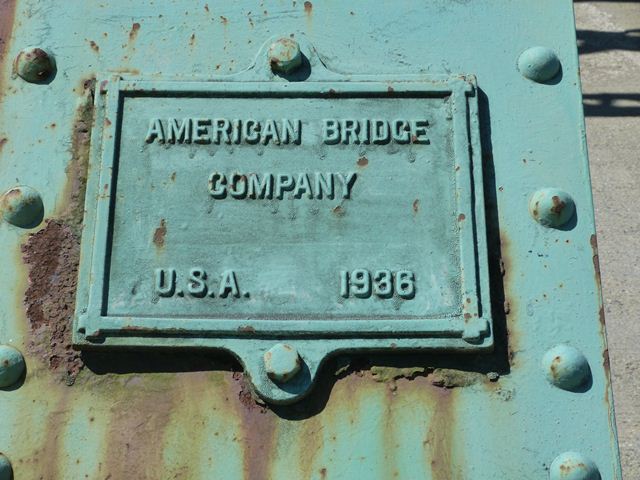We Recommend:
Bach Steel - Experts at historic truss bridge restoration.
BridgeHunter.com Phase 1 is released to the public! - Visit Now
Lisbon Falls Bridge
Durham Bridge

Primary Photographer(s): Nathan Holth
Bridge Documented: June 16, 2012
Lisbon Falls: Androscoggin County, Maine: United States
Metal Continuous Rivet-Connected Polygonal Warren Through Truss, Fixed and Approach Spans: Metal Stringer (Multi-Beam), Fixed
1936 By Builder/Contractor: American Bridge Company of New York, New York and Engineer/Design: Max L. Wilder, Maine State Highway Commission
Not Available or Not Applicable
168.0 Feet (51.2 Meters)
362.0 Feet (110.3 Meters)
22 Feet (6.71 Meters)
2 Main Span(s) and 1 Approach Span(s)
3334

View Information About HSR Ratings
Bridge Documentation
This bridge no longer exists!
View Archived National Bridge Inventory Report - Has Additional Details and Evaluation
View Original Plans For This Bridge
This bridge is one of only three known examples of continuous trusses in Maine that display the appearance of a very long simple span truss supported by piers. In this design, the truss has no "cantilever truss shape." Continuous trusses of this design are also extremely rare nationwide. Each of Maine's three examples of this design are distinctly unique, each employing different truss arrangements. Despite that fact, all three were built at around the same time. It is unknown why there is such a variance in design. The other two bridges are the West Buxton Bridge and the Bar Mills Bridge. Because each bridge is rare, both in Maine and nationwide, and given the unique appearance of each, the preservation of each example should be given a high priority. The Lisbon Falls Bridge is perhaps the most unusual of these three continuous truss bridges.
The Lisbon Falls Bridge has two truss spans (as opposed to the West Buxton and Bar Mills Bridges which have three spans). What is most unusual about the Lisbon Falls Bridge is that it is asymmetrical. The single pier is not located at the center of the bridge; the southern truss span is significantly shorter than the northern truss span. Another unusual feature is the stringer approach span at the northern end. East of the bridge, the road makes an immediate 90 degree turn to the west. To accommodate this sharp turn, the stringer span is flared, being noticeably wider at the northern end than the southern end. This is visible just by looking at the roadway, but is also vivid when viewing the stringers under the bridge. The stringer span passes over an enormous boulder or rock outcropping along the river bank.
The previous bridge at this location is documented in postcards. It consisted of two simple truss spans. Each span rested on an extremely large stone pier that was long enough that is separated the spans, making them look like two bridges. One span was a double-intersection Warren through truss, while the other was a smaller Warren truss. The bridge was destroyed in a flood, and the bridge seen today was the replacement bridge.
Information and Findings From Maine's Historic Bridge InventoryDiscussion of Bridge The 1936, continuous, riveted, Warren thru truss bridge is technologically significant as an early application of the continuous design. The first examples in Maine were for replacements of bridges lost in the
flood of March, 1936. This is one of 25 bridges built by MSHC to replace lost bridges, and it is one of three continuous-design Warren truss bridges built by the commission in 1936-37 as flood replacement bridges. All three early
examples, including #3340 and #3333, are historically and technologically significant. The significance of the bridge is linked to the continuous design. The bridge crosses the river at a 90-degree angle to the highways that
parallel the river. Bridge Considered Historic By Survey: Yes |
![]()
Photo Galleries and Videos: Lisbon Falls Bridge
Structure Overview
Original / Full Size PhotosA collection of overview photos that show the bridge as a whole and general areas of the bridge. This gallery offers photos in the highest available resolution and file size in a touch-friendly popup viewer.
Alternatively, Browse Without Using Viewer
![]()
Structure Details
Original / Full Size PhotosA collection of detail photos that document the parts, construction, and condition of the bridge. This gallery offers photos in the highest available resolution and file size in a touch-friendly popup viewer.
Alternatively, Browse Without Using Viewer
![]()
Structure Overview
Mobile Optimized PhotosA collection of overview photos that show the bridge as a whole and general areas of the bridge. This gallery features data-friendly, fast-loading photos in a touch-friendly popup viewer.
Alternatively, Browse Without Using Viewer
![]()
Structure Details
Mobile Optimized PhotosA collection of detail photos that document the parts, construction, and condition of the bridge. This gallery features data-friendly, fast-loading photos in a touch-friendly popup viewer.
Alternatively, Browse Without Using Viewer
![]()
Maps and Links: Lisbon Falls Bridge
This historic bridge has been demolished. This map is shown for reference purposes only.
Coordinates (Latitude, Longitude):
Search For Additional Bridge Listings:
Bridgehunter.com: View listed bridges within 0.5 miles (0.8 kilometers) of this bridge.
Bridgehunter.com: View listed bridges within 10 miles (16 kilometers) of this bridge.
Additional Maps:
Google Streetview (If Available)
GeoHack (Additional Links and Coordinates)
Apple Maps (Via DuckDuckGo Search)
Apple Maps (Apple devices only)
Android: Open Location In Your Map or GPS App
Flickr Gallery (Find Nearby Photos)
Wikimedia Commons (Find Nearby Photos)
Directions Via Sygic For Android
Directions Via Sygic For iOS and Android Dolphin Browser
USGS National Map (United States Only)
Historical USGS Topo Maps (United States Only)
Historic Aerials (United States Only)
CalTopo Maps (United States Only)


